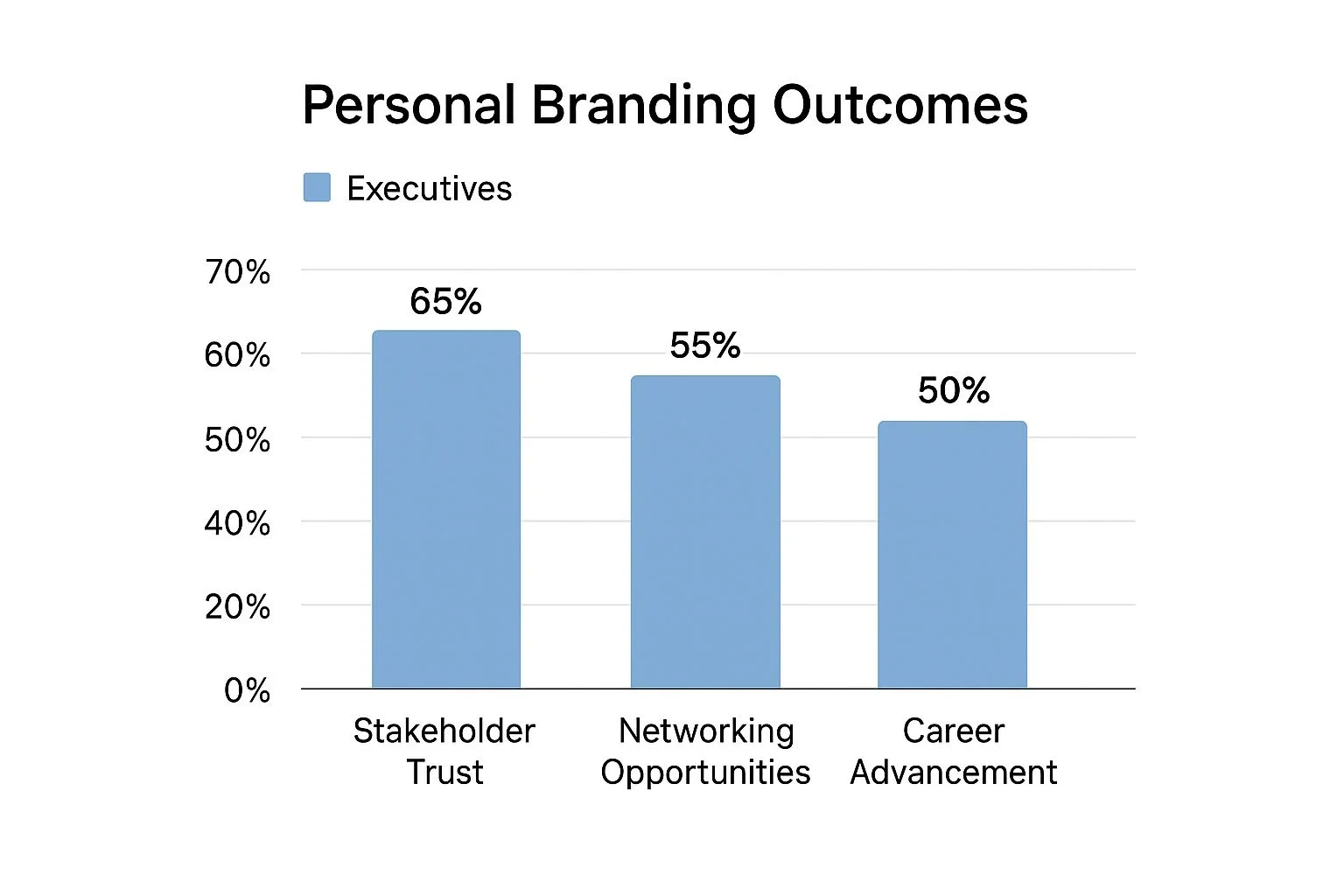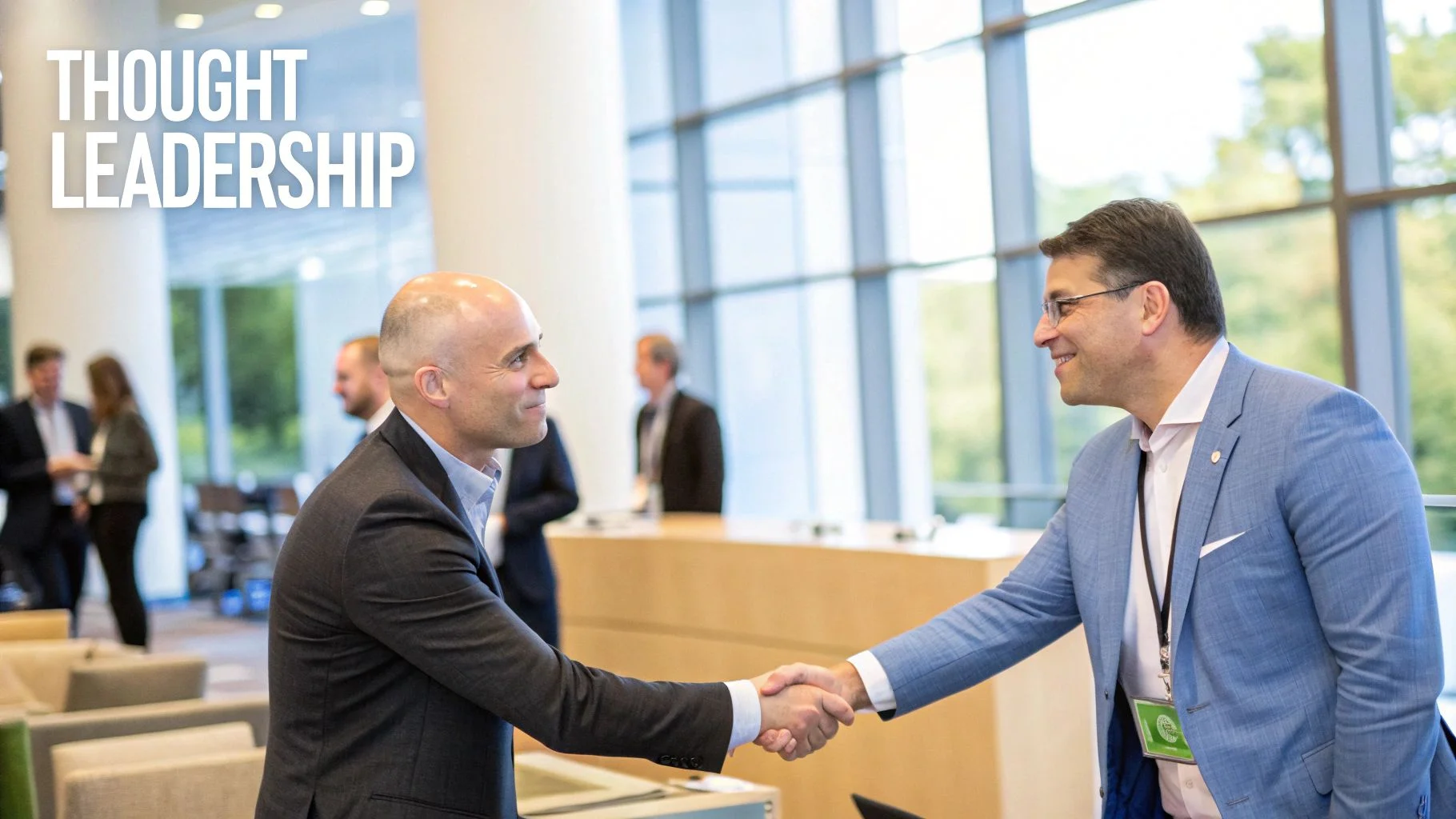Personal Branding for Executives: A How-To Guide
Build a powerful executive personal brand that drives company value, attracts talent, and establishes industry authority.

Personal Branding for Executives A How-To Guide
Let's be clear: executive personal branding isn't a vanity project. It's a strategic asset that directly pumps up your company's valuation, pulls in top-tier talent, and builds unshakable customer trust. This is about deliberately shaping how the world sees you, cementing your status as a go-to authority in your field.
Why Your Executive Brand Is a Strategic Asset
In today's business world, a leader's reputation and the company's are one and the same. When an executive is a ghost online, the company misses a massive opportunity to build real, human connection. A strong personal brand turns you from just a name on an org chart into a recognized, respected voice people actually want to listen to.
Picture two companies.
One is led by a CEO who's always sharing sharp insights on LinkedIn, jumping into meaningful conversations, and getting quoted in industry publications. The other is run by a CEO who's a complete unknown. Which company do you think attracts more media buzz, better job applicants, and greater investor confidence? It's a no-brainer. The visible leader is a known quantity, and that builds trust.
The Financial and Reputational Impact
This isn't just about feeling good about your online presence; it’s about real, measurable results. Let's talk numbers. Research shows 82% of people are more likely to trust a company when its top leaders are active on social media.
Even more staggering? An estimated 44% of a company's market value is tied directly to the CEO's reputation. That’s a massive financial weight resting on your personal brand. You can dig into more of the data on executive influence and market value if you're curious.
To make this crystal clear, I've put together a table showing the real-world difference between a strong and weak executive brand.
The Tangible Impact of an Executive Personal Brand
| Business Area | Executive with Strong Personal Brand | Executive with Weak Personal Brand |
|---|---|---|
| Talent Acquisition | Attracts top-tier candidates organically. Becomes a "talent magnet." | Struggles to attract high-quality applicants; higher recruitment costs. |
| Sales & Lead Gen | Generates 58% more leads. The personal brand acts as a trust signal. | Relies solely on traditional marketing; longer, colder sales cycles. |
| Investor Confidence | Inspires greater confidence, potentially leading to higher valuations. | Perceived as a higher risk; faces more scrutiny from investors. |
| Media & PR | Becomes a go-to source for journalists, securing earned media easily. | Overlooked for media opportunities; must pay for all press. |
| Customer Trust | Humanizes the company, building loyalty and stronger customer relationships. | Remains a faceless corporation, making trust harder to earn. |
The contrast is stark. A strong personal brand isn't just a "nice-to-have"—it's a core driver of business growth across the board.
This infographic breaks down the primary benefits executives see when they invest in building their brand.

As you can see, building trust with stakeholders is the biggest win, which then directly fuels everything from networking to career growth.
A strong executive brand acts as a magnet for opportunity. It doesn't just open doors; it brings people to your door—be it top talent, strategic partners, or loyal customers.
Bottom line? For any modern leader, personal branding is non-negotiable. It supports critical business functions and creates a ripple effect that strengthens the entire organization. When you build your brand, you’re not just moving your own career forward; you’re building a more resilient, trusted, and valuable company.
Defining Your Authentic Executive Brand
Before you can build a powerful personal brand, you have to know what it is. This isn't about inventing some new persona out of thin air. It’s about digging in and finding the authentic, foundational pillars that already define you as a leader.
Think of your brand as your promise of value. For it to stick, it has to be rooted in who you really are.
This isn't just a fluffy, modern trend, either. The whole idea of personal branding for executives has come a long way since it first popped up. It’s shifted from a nice-to-have to a core business strategy. Smart companies now actually want their leaders to build public personas. Why? Because employee voices often carry more weight and credibility than a polished corporate message. Your brand becomes a serious asset.
You can actually see the full evolution of this in these personal branding trends.
The real goal here is to move beyond your job title and create a narrative that sticks. What do you want to be known for? What unique angle do you bring to the table?
Uncovering Your Core Pillars
To build something that lasts, you have to start with a self-audit. Forget the abstract theories for a minute and ask yourself some direct questions that get to the heart of your professional identity. This isn't about what you think people want to hear—it's about what you genuinely stand for.
Start by digging into these three key areas:
Your Unique Expertise: What specific knowledge do you have that few others possess? Think way beyond your official role. If you had to teach a masterclass tomorrow, what topic could you talk about for hours without a single note? That’s the core of your authority.
Your Core Values: What principles guide your decisions, especially the tough ones? Think about what you would never compromise on, even if it cost the company money. Is it radical transparency? Unwavering customer focus? Sustainable innovation? These values become the ethical backbone of your brand.
Your Leadership Philosophy: How do you get people to act? Are you a coach who develops talent from the ground up? A visionary who paints a compelling picture of the future? Or a pragmatist who just executes flawlessly? Your leadership style is a huge differentiator.
Your authentic brand lives at the intersection of what you're passionate about, what you're exceptionally good at, and what your audience actually finds valuable. The goal is to find that sweet spot and own it.
Crafting Your Brand Narrative
Once you have clarity on those pillars, the next step is weaving them into a tight, powerful brand narrative. This isn't a long-winded biography. It’s a short, memorable story that communicates your value proposition instantly.
A great way to structure this is to answer three simple questions.
What problem do you solve? Who do you solve it for? How do you do it uniquely?
For example, a CTO’s narrative might be: "I help enterprise companies navigate complex digital transformations by implementing human-centered AI strategies."
This statement nails it. It clearly defines her expertise (AI-driven transformation), her audience (enterprise companies), and her unique approach (human-centered). This little narrative becomes the guiding star for every post you write and every comment you leave, ensuring your personal branding for executives is consistent and actually resonates.
Transforming Your LinkedIn Into a Brand Hub
Your LinkedIn profile is no longer a static, digital resume—it’s your professional headquarters. For any executive, this is the main stage where your reputation is built, deals get started, and you shape industry conversations. Just having a profile is table stakes. It needs to be an active, compelling hub that tells the story you want to tell.
The first step is to start treating your profile like a dynamic asset, not just a list of jobs and responsibilities. Every single section is a fresh opportunity to reinforce your expertise, share your unique perspective, and actually connect with people on a human level. A truly great profile doesn't just state what you do; it shows how you do it and, more importantly, why.
Your Headline Is Your Value Proposition
Most executives fall into the trap of using a simple "CEO at Company X" headline. That’s a massive missed opportunity. Your headline is the very first thing people read, and it should immediately scream the value you deliver. Think of it as your personal tagline.
Instead of just your title, frame your headline to answer the question, "What problem do I solve, and for whom?"
Before: Chief Technology Officer at Innovate Corp
After: CTO at Innovate Corp | Driving Growth Through Human-Centered AI & Scalable Tech Frameworks | Keynote Speaker on Digital Ethics
See the difference? The second version instantly signals expertise, specific skills, and areas of thought leadership. It shifts a passive title into an active statement of value, which is the core of effective personal branding for executives.
Crafting a Compelling Narrative in Your About Section
This is where your brand story truly comes to life. Please, avoid writing it like a stuffy, third-person corporate bio. Use a conversational, first-person voice to share your professional journey, your core values, and what you believe as a leader.
A powerful "About" section should weave together a few key elements:
Your Mission: Kick things off with a strong opening statement that gets to the heart of your purpose.
Your Journey: Briefly touch on the key experiences that shaped who you are today.
Your "How": Explain your unique approach or the philosophy that guides your work.
Call to Action: End by telling people how you'd like to connect or what topics you're fired up to discuss.
Think of your "About" section as your personal manifesto. It's your chance to articulate what drives you beyond the P&L, building a much deeper connection with people who get it.
Spotlight Your Expertise with the Featured Section
The "Featured" section is basically your personal content portfolio, pinned right at the top of your profile. This is where you put your money where your mouth is and showcase your thought leadership in action.
Use this prime real estate to highlight things like:
Articles you've written on LinkedIn or other sites.
Podcasts or interviews where you were a guest.
Recordings of keynote presentations or webinars.
Big company news or successful projects you spearheaded.
This section offers tangible proof of your expertise, giving visitors a chance to engage with your ideas the moment they land on your profile.
And of course, managing all this content consistently can feel like a chore. That's where you can get smart with your workflow.

Tools like Social Presence can help turn brand-building from a grind into a manageable part of your daily routine by making it easier to interact and share content. Building a killer profile is only half the battle; consistently showing up with valuable content is what makes it a true brand hub. For more on that, check out our guide to building a winning LinkedIn content strategy.
Creating Content That Builds Authority

Okay, your brand foundation is solid and your LinkedIn profile is looking sharp. Now for the fun part: bringing your expertise to life with content. This is the shift from having a passive, static profile to becoming an active, authoritative voice in your industry.
Think of it this way: consistent content is the engine that drives your entire personal brand as an executive.
You don’t have to become a full-time creator overnight. The goal is to strategically share what you know, build trust, and prove you stand for what you say you stand for. It’s about being generous with your insights.
Develop a Sustainable Content Mix
Here's a hard truth: consistency will always beat intensity. You don't need a perfectly polished video every single day. A sustainable strategy is all about mixing different content formats that play to your strengths and, just as importantly, fit into your schedule.
A balanced, manageable content mix could look something like this:
Text-Based Insights (Low Effort): These are your bread and butter. Quick, impactful posts sharing an opinion on an industry trend, a lesson from a recent project, or a key takeaway from a book you're reading. They're the easiest way to keep the momentum going.
Carousels or Visuals (Medium Effort): Got a complex idea? Break it down into a few simple slides. This format is a magnet for engagement on LinkedIn and immediately positions you as a teacher.
Short Videos (High Effort): A 60-90 second video sharing a core leadership principle or answering a common question. Yes, they take more work, but nothing builds a human connection faster than video.
By mixing it up, you keep your feed from getting stale and make the whole content creation process feel less like a chore. For a deeper dive, check out our guide on the different content types that drive engagement.
Overcome the Time Crunch with Smart Repurposing
The biggest roadblock for any executive? Time. No question. The solution isn't to find more hours in the day—it's to work smarter by repurposing a single piece of content into multiple assets. This "one-to-many" strategy is a total game-changer.
Imagine you record one 30-minute podcast interview. That one recording can fuel your content calendar for weeks.
The Full Interview: Post the entire audio or video. This is your "pillar" content.
Short Video Clips: Pull out 3-5 compelling, 1-minute clips to share as individual video posts.
Quote Graphics: Turn the most powerful statements from the interview into sharp, shareable quote graphics.
Text-Based Posts: Transcribe the audio and expand on a few key ideas in separate text posts, adding new context each time.
Just like that, one piece of effort has turned into nearly a dozen unique posts. This is exactly how you build authority without burning out.
From Broadcasting to Engaging
Creating content is only half the battle. The other half is getting into the trenches and engaging authentically with your community. That means adding thoughtful comments to other people's posts, asking smart questions, and showing up in relevant conversations.
True authority isn't just about what you broadcast; it's built in the thoughtful replies and genuine conversations you have with your peers and audience. Engagement turns a monologue into a dialogue.
This isn’t just a nice-to-have. It’s critical. Research shows that up to 44% of a company's market value can be tied directly to the CEO's reputation. On a platform like LinkedIn, which has over 1 billion members, your engagement is a direct reflection of your leadership and contributes to that valuation.
The ultimate goal isn't just to build an audience—it's to build a community.
Measuring the ROI of Your Personal Brand

Let's be clear: investing in your personal brand is a hard-nosed business decision, not a side project for your ego.
So, how do you prove it’s actually working? How do you show your board, your team, or even just yourself that all this effort is paying off in real, tangible results?
The secret is to look past the shallow "vanity metrics." Sure, likes and views feel good, but they don't tell you the whole story. The real return on your personal branding for executives shows up in business-focused key performance indicators (KPIs) that directly translate to growth and opportunity.
Focusing on Business-Oriented KPIs
To really see the impact, you need to track the numbers that signal genuine influence and business momentum. These are the metrics that prove your authority is growing and pulling in the right kind of attention.
Start by keeping a close eye on these high-value indicators:
Inbound Connection Requests: Who is reaching out to you? When leaders from target accounts, potential strategic partners, or top-tier talent start sending you unsolicited requests, you know your content is hitting the mark.
Unsolicited Opportunities: Track every single invitation to speak at a conference, appear on a podcast, or join an advisory board that came directly from your online presence. These are the dividends of your thought leadership, paid in full.
Media Mentions: Keep a simple log of every time you're mentioned in an industry publication or major media outlet. This "earned media" is a massive validator of your brand's authority and expands your reach exponentially.
The real measure of your brand's ROI isn't just a bigger follower count. It's the quality of the doors that open for you without you ever having to knock. Those inbound opportunities are the clearest signal that your influence is truly growing.
Assessing Qualitative Wins
Not everything that counts can be counted. The qualitative wins from your personal brand are just as critical and often spark the biggest breakthroughs. These are the results that build long-term value for your career and your company.
Think about the caliber of the new relationships you’re building. Are your conversations shifting from superficial online comments to meaningful offline discussions about real collaborations? That jump from a wide network to a powerful, engaged community is a huge qualitative victory.
We dig into the crucial difference between the two in our guide on followers vs. connections.
When you track both the hard numbers and these softer, qualitative shifts, you get the full picture. A simple dashboard monitoring these KPIs can clearly demonstrate the immense value your personal brand brings to the table, justifying every minute you invest and cementing your position as a leader who truly matters.
Common Executive Branding Questions Answered
Even with a solid game plan, it's completely normal to hit a few roadblocks when you first start building your personal brand. These questions pop up all the time.
Let's walk through the most common hurdles I see and give you some straight-up, practical answers so you can keep moving forward.
Building an effective personal brand as an executive isn't about adding another full-time job to your already packed schedule. The real goal is consistency, not overwhelming intensity.
How Much Time Do I Really Need to Invest Each Week?
You don't need to spend hours glued to your screen every day. A focused effort of just 2-3 hours per week can be incredibly effective, especially when you zero in on high-impact activities.
What does that actually look like?
It breaks down into small, manageable chunks. Think about sharing one thoughtful post, then spending just 15-20 minutes a day engaging in real conversations. When you use tools to streamline the process, you build a sustainable routine that compounds over time.
What If My Company Has Strict Social Media Policies?
This is a big one, and it's a completely valid concern, especially if you're in a regulated industry like finance or healthcare. The best approach here is to get proactive and collaborative, not to hide and hope for the best.
Get a meeting on the calendar with your compliance, legal, or marketing team. Go in with the goal of understanding their guidelines inside and out. It helps to frame your branding efforts as a strategic asset—something that elevates the company's reputation and cements its position as a thought leader.
More often than not, these policies are in place to stop the accidental leak of sensitive info, not to muzzle executives. By working together, you can create a clear set of do's and don'ts that aligns your personal brand with the company's rules.
The executives who nail this operate in partnership with their company's compliance and marketing teams. This alignment transforms a potential obstacle into a powerful, unified message that boosts both your brand and the corporate mission.
How Can I Build a Brand Without Sounding Like I'm Bragging?
This is all about shifting your mindset from promotion to contribution. A powerful personal brand is built on generosity—on adding real value to your network, not just shouting about your own wins.
A great rule of thumb is the 80/20 rule:
80% of your content should be dedicated to educating, helping, and offering unique insights to your audience. Share what you know, comment on industry news, and shine a spotlight on the great work of others.
The remaining 20% can be reserved for your company's successes, your personal achievements, or projects you're spearheading.
When you consistently show up to give value, that small slice of self-promotion feels earned and natural, not boastful.
Ready to build your brand without the burnout? Social Presence helps you show up consistently, generate thoughtful comments with AI, and focus on the connections that matter most. Streamline your LinkedIn engagement and build your authority in just a few minutes a day. Discover Social Presence.